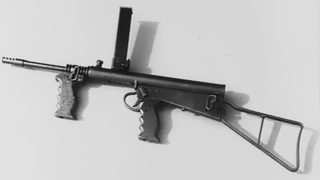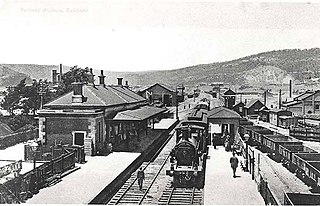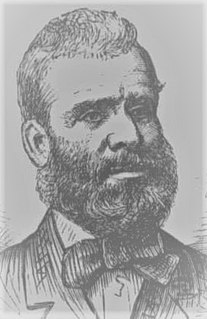
BlueScope Steel Limited is an Australian flat product steel producer with resources coming in from New Zealand, Pacific Islands, North America, and Asia.

Corrugated galvanised iron or steel, colloquially corrugated iron, wriggly tin, pailing, corrugated sheet metal and occasionally abbreviated CGI is a building material composed of sheets of hot-dip galvanised mild steel, cold-rolled to produce a linear corrugated pattern in them. Although it is still popularly called "iron" in the UK, the material used is actually steel, and only the surviving vintage sheets may actually be made up of 100% iron. The corrugations increase the bending strength of the sheet in the direction perpendicular to the corrugations, but not parallel to them, because the steel must be stretched to bend perpendicular to the corrugations. Normally each sheet is manufactured longer in its strong direction.

Lithgow is a town in the Central Tablelands of New South Wales, Australia and is the administrative center of the City of Lithgow local government area. It is located in a mountain valley named Lithgow's Valley by John Oxley in honour of William Lithgow, the first Auditor-General of New South Wales.

The Owen gun, which was known officially as the Owen machine carbine, was an Australian submachine gun designed by Evelyn Owen in 1939. The Owen was the only entirely Australian-designed and constructed service submachine gun of World War II and was used by the Australian Army from 1943 until the mid-1960s.

Lysaghts is an intercity train station located in Spring Hill, Australia, on the South Coast railway line's Port Kembla branch. The station serves NSW TrainLink trains travelling south to Port Kembla and north to Wollongong and Sydney. The station is surrounded on both sides by the Lysaght factory at Spring Hill. Trains only stop on request. There is no way out of the station unless commuters work at the neighbouring steelworks.

Port Kembla is a single-platform intercity train terminal located in Port Kembla, Australia, on the South Coast railway line's Port Kembla branch. The station serves NSW TrainLink trains travelling north to Wollongong and Sydney. The station also serves as a stabling location for South Coast line trains.
John Lysaght and Co. was an iron and steel company established in Bristol, England, and with later operations in Wolverhampton, Newport, and Scunthorpe. The company was acquired by GKN in 1920.

JSW Ispat Steel Ltd (JISL) was set up as Nippon Denro Ispat Limited in May 1984 by founding chairman Mr M L Mittal. The company have operations in iron, steel, mining, energy and infrastructure. It has two integrated steel plants, located at Dolvi and Kalmeshwar in the state of Maharashtra. The 1,200 acres (4.9 km2) Dolvi complex houses the 30 lakh tonne per annum hot rolled coils plant, which combines the latest technologies – the Conarc process for steel making and the compact strip process (CSP) – introduced in Asia. The company is listed on Bombay Stock Exchange and National Stock Exchange of India. It is headquartered at Mumbai and employs about 3,000 people. Ispat Industries was ranked 5th among major next to Tata steel and JSW steel companies in India for the year 2008 by Business World.

JSW Steel Ltd. is an Indian multinational steel making company based in Mumbai, Maharashtra. It is a subsidiary of JSW Group. It is one of the fastest growing companies in India with a global footprint in over 140 countries. After the merger of ISPAT steel, JSW Steel has become India's second largest private sector steel company. The current installed capacity of the company stands at 18 MTPA. A $13 billion conglomerate, with presence across India, USA, South America & Africa, the JSW Group is a part of the O.P. Jindal Group with strong footprints across core economic sectors, namely, Steel, Energy, Infrastructure, Cement, Ventures and Sports. JSW's history can be traced back to 1982, when the Jindal Group acquired Piramal Steel Limited, which operated a mini steel mill at Tarapur in Maharashtra and renamed it as Jindal Iron and Steel Company (JISCO).

William Sandford was an English-Australian ironmaster, who is widely regarded as the father of the modern iron and steel industry in Australia.

The Fitzroy Iron Works at Mittagong, New South Wales, was the first commercial iron smelting works in Australia. It first operated in 1848.

NSW Wallaby was a steam locomotive seeing service in New South Wales.
The D9 class were a class of diesel locomotives built by English Electric, Rocklea for Australian Iron & Steel's, Port Kembla steelworks between 1956 and 1960.
Howard Smith Limited was an Australian industrial company. Founded in 1854 as a shipping company, it later diversified into coal mining, steel production, stevedoring, travel, railway rolling stock building, sugar production and retail. Its divisions began to be sold off in the 1990s with the remainder taken over by Wesfarmers in August 2001.

The Lithgow Blast Furnace is a heritage-listed former blast furnace and now park and visitor attraction at Inch Street, Lithgow, City of Lithgow, New South Wales, Australia. It was built from 1906 to 1907 by William Sandford Limited. It is also known as Eskbank Ironworks Blast Furnace site; Industrial Archaeological Site. The property is owned by Lithgow City Council. It was added to the New South Wales State Heritage Register on 2 April 1999.

The Eskbank railway station is a heritage-listed former locomotive depot and railway station and now community group venue adjacent to the Main Western Line at Lithgow, City of Lithgow, New South Wales, Australia. It was designed by the New South Wales Government Railways and the station building was built by Goodsell & Wright, as a contractor. It is also known as Eskbank Railway Station group and Lithgow Goods Station/ Lithgow Site S1. The property was added to the New South Wales State Heritage Register on 2 April 1999.

Enoch Hughes was an English-born iron-master and pioneer of the iron industry in both Australia and New Zealand.

Eskbank House is a heritage-listed former mine owner's residence, iron and steel works manager's residence, school and boarding house and now museum, event venue and community resource centre at 70 Inch Street, Lithgow, City of Lithgow, New South Wales, Australia. It was designed by an unknown architect and built from 1841 to 1842 by Alexander Binning, a stonemason, using convict labour. It is also known as Eskbank House and Moveable Collections and Esk Bank House; The Grange. The property is owned by Lithgow City Council. The residence was added to the New South Wales State Heritage Register on 24 August 2018.

Charles Henry Hoskins (1851-1926) was an Australian industrialist, who was significant in the development of the iron and steel industry in Australia.
Australian Iron & Steel was an Australian iron and steel manufacturer.
















